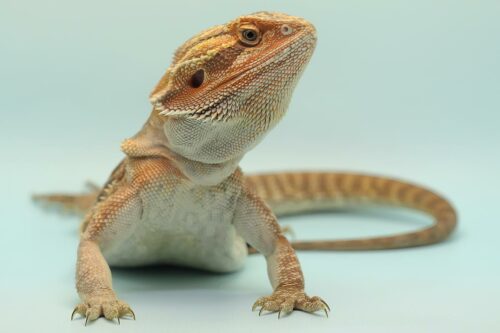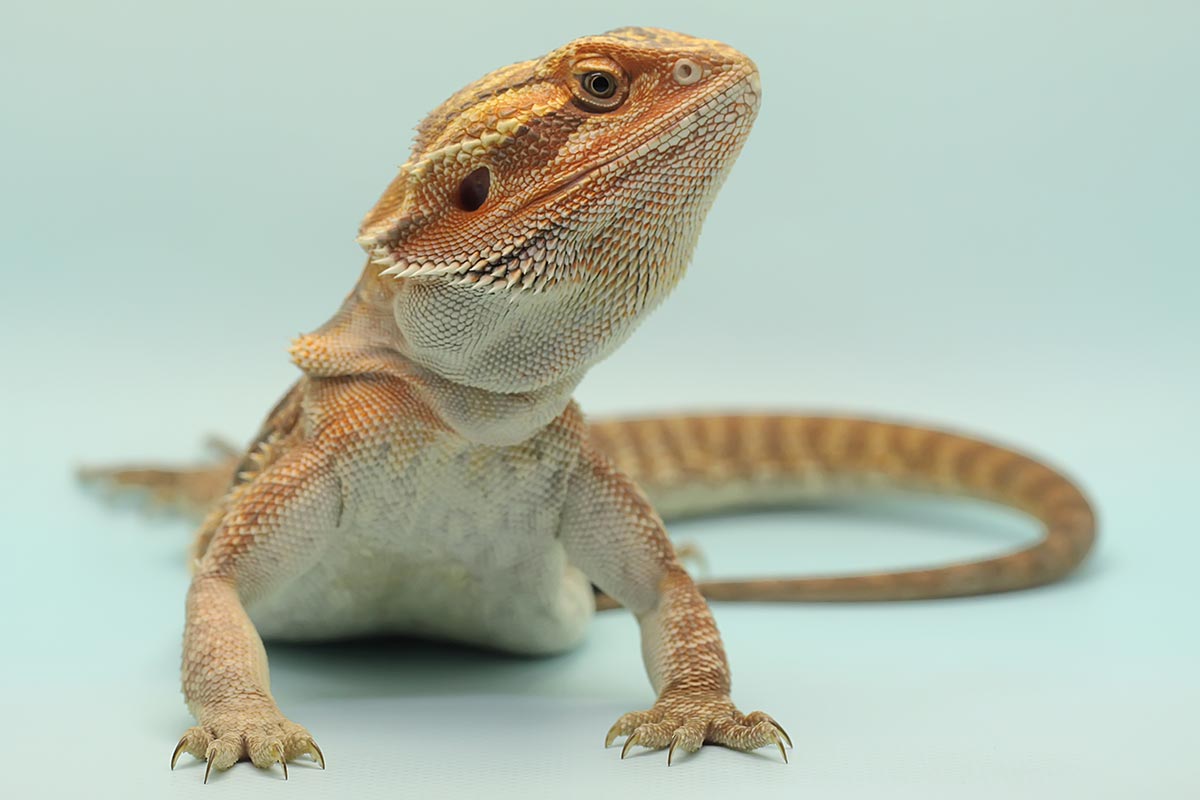Are you wondering why you need to cut your bearded dragon’s nails when, clearly, this isn’t something that happens in the wild?
This is because the living conditions of wild beardies and your pampered pet are not the same, and your beardie’s claws probably won’t wear down naturally the way they do in the wild.
Letting your bearded dragon’s nails grow too long is a risk to their health as well as a potential scratch risk for you, so today we’ll look at what can happen if the nails do get too long and why you should trim them regularly.

We’ll also talk about how often and how to know when they need to be cut.
Finally, we’ll share exactly how to cut your bearded dragon’s nails in a safe and pain-free way, to keep your reptile companion healthy and happy. Beyond bathing, this is the most important grooming task for your beardie.
Why Cut Your Beardie’s Nails?
In the wild, bearded dragons spend hours every day traveling across rough surfaces such as rocks, sand, and gravel. This naturally wears down their sharp claws and keeps them at a manageable length.
But your beardie, in their clean tank with their bouncy substrate designed to protect their joints, doesn’t come into contact with the same abrasive surfaces on a regular basis.
The result is that their nails don’t wear down naturally and they can get pretty long, pretty fast.
While long, curled claws on your beardie might look good aesthetically, it is not good for them or for you.
First, overly long nails aren’t very usable. This can make it difficult for your bearded dragon to do the things they need to do, especially climbing.
Long nails also have a great tendency to get caught in things, such as the substrate of your beardie’s tank. This can cause their nails to rip off. At best, this can be painful..
If the nail breaks inside the quick (the part of the nail with the blood vessels, like the pink part of human nails), it will be very painful for them. If the claw rips off completely, it will never grow back, and they will be without this essential tool for the rest of their lives.
If your bearded dragon has overly long, sharp nails, they’re also more likely to scratch things. This could be the clean glass surface of their tank, or it could be your skin during handling.
Not only can this be pretty painful for you, but the claws tend to be a breeding ground for bacteria. Scratches from these nails can lead to serious infections.
If the nails get too long, they can curve around on themselves and dig into your bearded dragon’s own skin, too. They will be susceptible to infections from that same bacteria.
Finally, nails that are too long can also cause deformities, pushing your bearded dragon’s toes out of alignment, which can cause them to twist as they move around.
This can be painful, and if left for too long, can cause permanent deformity. They will forever have pain and issues with movement.
So, it’s fair to say that letting your bearded dragon’s nails grow out of control is a risk to them and a risk to you, so you should cut them regularly.
When To Cut Your Bearded Dragon’s Nails
So, how do you know when your bearded dragon needs to have their nails cut?
It’s difficult to say exactly since it will depend on their activity level and the type of surfaces they come into contact with. But as a general rule, you can expect to cut your beardie’s nails three or four times a year. This is often best done at the start of each season.
But, since every animal is different, you also need to keep an eye on your bearded dragon’s nails to see when they’re getting too long. If you’re getting scratched, this is a pretty sure sign that it’s time for a cut.
To really examine your beardie’s nails, place them on an elevated flat surface so you can get eye level with their feet. Take a close look. If their nails are pushing their toes up by more than 90 degrees, then it’s time for a trim.
Read our guide to the healthiest food for your bearded dragon.
How To Cut Your Beardie’s Nails
How exactly do you go about cutting your bearded dragon’s nails? It’s not too different from cutting your own nails or those of a dog or cat. All you need to do is identify the excess nail point and snip it off with clippers. Of course, this can be easier said than done.
The first thing to consider is the clippers you’ll use. You certainly can use standard nail clippers, but investing in a set of pet animal clippers that are also used for dogs and cats is recommended.
This is because normal clippers add cutting pressure from two sides. This works well for flat human nails, but animals, including bearded dragons, have circular nails. Pet nail clippers are designed to provide circular pressure, keeping the pressure even across the nail.
We recommend either the Pecute Nail Clippers with a sharp stainless steel curved head and an LED light to help with visibility, or these simple Candure Nail Clippers.
Of course, make sure you sterilize your tools with rubbing alcohol before and after use to limit the spread of bacteria.
Nail cutting is not painful for your bearded dragon, so as long as they don’t mind being handled, it shouldn’t be too difficult to get them to cooperate.
Some people choose to cover their beardie’s head with a small towel for 10 minutes before cutting. This helps simulate darkness and the sleep cycle, which means they’ll be more relaxed during the trimming process.
When you have your beardie’s foot in your hand, you’ll need to identify how much of the nail to remove.
The key is identifying the dead point of the nail and the quick, which is the living part of the nail filled with nerves. If you cut into the quick, it will be painful and there will be blood.
While you can’t see the quick on bearded dragon’s nail, you can feel it. As you run your finger over the nail, you should feel a bump where the quick ends.
You want to cut a millimeter or so beyond that, toward the tip. It may feel like you aren’t removing much, but even a few millimeters can make a big difference to your reptile’s health.
Remember that your bearded dragon probably doesn’t like having their feet and tail handled.
While you’ll obviously need to touch their feet as part of the nail trimming process, be gentle and do as little handling as possible. Secure them around the body to keep them in place.
Make sure you have Styptic Powder on hand in case you accidentally cut into the quick. This will help stop the bleeding quickly and also close the wound to prevent bacteria from entering your beardie’s system.
Some people do get nervous about cutting their bearded dragon’s nails because of fear of cutting into the quick. If this is you, you can file the nail instead, using a simple nail file or an electric nail grinder.
However, we don’t recommend this as better than clipping for two main reasons: First, if you use a standard nail file, this will take a long time.
You can’t really expect your bearded dragon to sit still and comfortably for an extended period of time while you do this. If you’re using a faster electric grinder, it will make a lot of noise.
Even the most tranquil beardie might be uncomfortable if you approach them with this in hand.
Cutting Bearded Dragon Nails FAQs
Are you supposed to cut bearded dragon nails?
If you have a bearded dragon in captivity, you will need to cut their nails at least a couple of times a year.
This is because they don’t consistently come into contact with the same abrasive surfaces that they do in the wild, which naturally files down their nails. So they need to be cut regularly so they don’t hurt themselves or start scratching you.
Does cutting bearded dragon nails hurt?
When done properly, it shouldn’t hurt your bearded dragon when you cut their nails. Like when you cut your own nails, the white part of the nails are dead cells and there’s no pain when they’re trimmed.
But if you cut too deeply, down into the quick where the nerves are, it can be very painful.
If your bearded dragon doesn’t mind being handled, they should be quite relaxed about the clipping process. But if they’ve had a traumatic experience where their quick has been cut, they may instinctively pull away when you start handling their feet.
Does it hurt if you bearded dragon bites your finger?
Bearded dragons do have sharp little teeth that can hurt your skin, but they don’t have a strong jaw so there’s no risk of them causing serious damage.
It might hurt a little, and you should clean the area around the bite to prevent infection, but a bite from a beardie is usually nothing to worry about.
What if you hold a bearded dragon too much?
Bearded dragons are among the most friendly of reptiles and they tolerate being handled more than others, but it can be stressful for them if you handle them too much.
It’s best to leave your active handling of your beardie to the essentials, such as bathing and nail trimming.
Other than that, you can keep them close to you and let them decide how much contact they want. If they decide to crawl on you, they might be willing to receive a stroke.
What happens if you don’t wash your hands after touching a bearded dragon?
You should always wash your hands after handling a bearded dragon because they carry Salmonella germs. If you then touch your mouth or your food, you can ingest the Salmonella and become very sick.
Do bearded dragons show pain?
There are many body language cues that could indicate your bearded dragon is feeling pain. Flinching is a response to immediate pain.
For longer-term pain, you can expect a reduction in movement, strange posture and movements, increased aggression, less vibrant color, and loss of appetite and weight.
Bearded Dragon Grooming
Aside from regular bathing, which should happen two to three times a week for most beardies, nail trimming is the most important grooming essential for your bearded dragon.
Aside from this, as long as their tank is kept clean and at the right temperature and humidity levels, your bearded dragon should more or less look after themselves.
If you prefer a more natural approach to caring for your bearded dragon, you can choose to include abrasive substrates in your tank that will naturally wear down their nails.
But they will probably still need the occasional trim. This is because living in a tank limits their activity level, so they won’t spend as much time clattering across terrain as they would in the wild.
Nevertheless, your bearded dragon will surely thank you for the consideration.
Read our complete bearded dragon care sheet here.
- Can Guinea Pigs Eat Potatoes? Foods To Avoid - September 24, 2023
- Can Guinea Pigs Eat Carrots? Feeding Advice - September 23, 2023
- How To Make A DIY Bearded Dragon Enclosure - September 22, 2023

